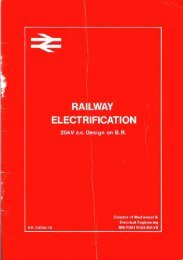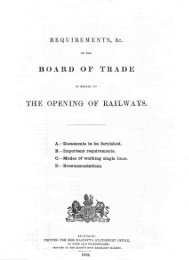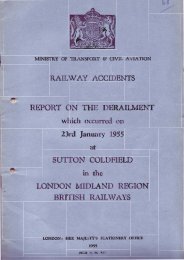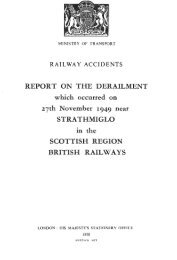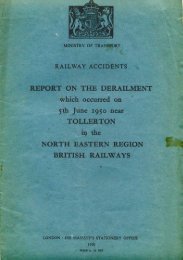R A I LT R AC K - The Railways Archive
R A I LT R AC K - The Railways Archive
R A I LT R AC K - The Railways Archive
You also want an ePaper? Increase the reach of your titles
YUMPU automatically turns print PDFs into web optimized ePapers that Google loves.
Route characteristics<br />
DESCRIPTION This route links south London and the South Coast to London’s<br />
West End (at Victoria) and the City (via London Bridge). Over the busiest<br />
section, between Clapham Junction and Balham, the route carries some 700<br />
trains per day, making it one of the most heavily used routes in Great Britain. <strong>The</strong><br />
route also caters for a large leisure market, providing access to Gatwick Airport,<br />
central London, and to the resorts of the Sussex Coast.<br />
<strong>The</strong> core route is four track from Victoria and London Bridge until it reaches<br />
Balcombe Tunnel where it becomes two track for much of the remainder of its<br />
length to Brighton. Linespeed is vari a ble but predominantly 60mph within Greater<br />
London, 90mph elsewhere, and with a short stretch of 100mph.<br />
<strong>The</strong> West London Line (WLL) connects the West Coast Main Line, North<br />
London Line and Great Western Main Line with the south London network. This<br />
two-track line has a predominant linespeed of 40mph, with a short section of<br />
60mph and flat, low-speed entry and exit junctions.<br />
Other lines are predominantly two track, with linespeeds 60–75mph. With<br />
the exception of the line between Hurst Green and Uckfield, the route is<br />
electrified throughout.<br />
MAJOR STATIONS<br />
Gatwick Airpor t This station handles rail traffic to the UK’s second busiest<br />
airport, at which significant growth is expected over the next ten years. A<br />
package of SRP work has been completed, which includes lighting improvements,<br />
and new, enhanced waiting areas and toilets. Way-finding improvements will be<br />
made during 1999 to improve access between the station and airport terminals.<br />
We intend to renew the customer-information system during 1999/2000. We will<br />
also work with BAA to develop longer-term proposals to radically improve the<br />
rail/air interchange, provide capacity for the anticipated growth and ensure a<br />
long-term growth in rail share of this market.<br />
London Victoria As our busiest major station, Victoria handles south London,<br />
Kent and Sussex commuting and interurban business, as well as providing a<br />
specialist facility for Gatwick Express. In 1999/2000 we will provide a modest<br />
airline check-in facility in the station concourse and work with Connex to<br />
provide automatic ticket gates for their platforms. We also intend to start station<br />
regeneration work during 1999 and are in the process of developing new<br />
information and ticketing facilities.<br />
BOTTLENECK ANALYSIS<br />
Victoria to Haywards Heath <strong>The</strong>re are a number of related capacity<br />
constraints between Victoria and Haywards Heath. A key constraint is Windmill<br />
Bridge Junction where the four-track routes from Victoria and London Bridge<br />
combine into one four-track railway. Other capacity constraints on this section<br />
include limited platform availability at both Victoria and Gatwick Airport stations<br />
due to platforms dedicated to Gatwick Express Services and station dwell times<br />
at Clapham Junction. <strong>The</strong> number of tracks and platform availability are also<br />
constraints at East Croydon.<br />
Option A Retimetable to improve use and release capacity. A detailed exercise<br />
has been carried out, showing that it would only be possible to release one<br />
additional path on the fast lines by retimetabling while meeting existing customer<br />
aspirations.<br />
Option B Lengthening of existing trains and platforms to increase passengercarrying<br />
capacity on existing services. In addition to the vehicle leasing cost<br />
involved, this would require platform lengthening and track layout changes at<br />
Victoria, East Croydon and Gatwick Airport and a number of other locations.<br />
This would, however, increase ability to carry additional passengers without<br />
running extra trains.<br />
Option C Use of rolling stock with increased seating capacity on existing<br />
services. This would increase ability to carry additional passengers without<br />
running extra trains. Up to 20% additional passengers could be carried in the<br />
peak, thereby reducing the need for additional paths or longer trains. New rolling<br />
stock would be required to achieve this.<br />
Option D Use of rolling stock with higher-speed and better performance<br />
characteristics. This would facilitate better use of the available capacity. However,<br />
it would only be of benefit if the majority of the rolling stock on the route was<br />
replaced at the same time.<br />
Option E Infrastructure solution to increase route capacity in the peak. In order<br />
to avoid simply shifting the bottleneck from one location to another, capacity can<br />
only be released through addressing a number of constraints at various points<br />
along the route. <strong>The</strong> infrastructure enhancement involves:<br />
• construction of a flyover at Windmill Bridge Junction (to remove down<br />
Victoria/up London Bridge conflicts)<br />
• additional platforms at Gatwick Airport Station<br />
• upgrade carriage roads at Victoria and Brighton<br />
• upgrade power supply along the route<br />
• operational changes (reduce turnaround times for trains, and restructure the<br />
timetable).<br />
<strong>The</strong> combined effects of the above infrastructure work would create capacity for<br />
up to four additional trains per hour on both fast and slow lines.<br />
Option F Infrastructure solution to increase route capacity in the off-peak.<br />
Again, in order to avoid simply shifting the bottleneck from one location to<br />
another, capacity can only be released through addressing a number of<br />
constraints at various points along the route. <strong>The</strong> infrastructure involves:<br />
• provision of additional turnback capacity at Gatwick Airport<br />
• provision of an additional 40mph junction between fast and slow lines near<br />
Clapham Junction<br />
• restructuring the timetable between Balcombe Tunnel Junction and Brighton.<br />
This would allow an increase of six off-peak trains per hour in services from the<br />
north terminating at Gatwick Airport and would deliver a number of customer<br />
aspirations. In addition, action would be required on the West London Line at<br />
the junctions of both WCML and GWML.<br />
Our preferred long-term option would be to undertake the complete<br />
infrastructure works required to de-bottleneck the route if there were sufficient<br />
industry funding. Option E is chosen as it is the only solution to provide any<br />
significant benefit in terms of capacity. However, in the shorter term, options A,<br />
C, and D would provide significant improvement in seating capacity on the route.<br />
West London Line <strong>The</strong> West London Line is used by a wide mix of local and<br />
long-distance passenger and freight traffic. This section of route is bounded by<br />
the WCML, GWML, Brighton Main Line and Channel Tunnel Routes. <strong>The</strong> entry<br />
and exit points to the route are mainly via single-lead and flat junctions and<br />
linespeed is low. <strong>The</strong>se adjoining routes all have their own capacity constraints<br />
and restrict timetabling flexibility. As a result, use of the available capacity is<br />
dictated by peaks elsewhere as much as by those on the line itself, and varies<br />
widely through the day with a single mid-day peak rather than distinct morning<br />
and evening commuter peaks. During the busiest hours, there is little spare<br />
capacity. <strong>The</strong>re is insufficient capacity to meet PSR, contractual rights and<br />
franchise commitments as well as local authority and developer aspirations to<br />
open additional local stations on the line.<br />
Option A Retimetabling to facilitate better use of the existing capacity. It is not<br />
considered that retimetabling on the West London Line at this stage would be a<br />
practical option, given the fact that it is a key artery linking so many routes. Any<br />
retimetabling is likely to have a significant effect on the timetable for much of the<br />
rest of the network.<br />
It is recommended that no retimetabling be carried out at this stage.<br />
However, it is planned to revisit this in conjunction with the timetabling review to<br />
be undertaken for completion of Phase 1 of CTRL works.<br />
Option B Relax capacity constraint over Chelsea River Bridge by increasing<br />
linespeed. Chelsea River Bridge curr e n t ly has restricted speeds, due to its<br />
condition and track alignment on its approaches. In addition, the signal spacing is<br />
greater than for the rest of the line. A headway improvement of 20 seconds could<br />
be achieved by strengthening the bridge and providing an additional signal.<br />
Either of these would increase capacity by between one and two paths<br />
per hour.<br />
Option C Examine linespeed profile in an attempt to make it more unifo rm .<br />
C u rr e n t ly, differential speeds along the route prevent effe c t i ve use of the av a i l a bl e<br />
c a p a c i t y. An assessment has been undert a ken to determine whether the existing<br />
p r o file can be smoothed to provide an increase in capacity. We consider it unlike ly<br />
that increasing speeds on the line would produce a significant capacity enhancement.<br />
H owe ve r, it would aid timetabling and perfo rmance reliability on this route.<br />
233



